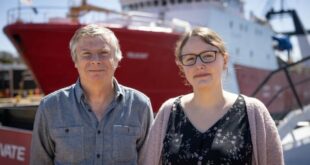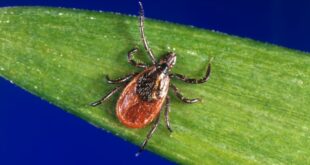When the base of the food chain changes, it effects everything else above it.

Algae growing in Canada’s deepest lake have changed dramatically in the past couple of decades according to new study — and although one researcher considers the new microscopic organisms to be “beautiful” he says it’s “definitely” going to have repercussions for the rest of the food chain.
John Smol, a biology professor at Queen’s University in Ontario and a co-author of the study, said around the turn of the 21st century, a small-celled type of algae replaced the larger type of chain-forming algae that used to be dominant in Great Slave Lake in the N.W.T.
“We’re quite surprised how striking the change was,” said Smol, who’s studied algae for more than four decades.
Smol attributes the “very sharp transition” to climate change, which is warming the Arctic and sub-Arctic more quickly than other parts of the world. There’s less ice cover on Great Slave Lake, he said, meaning the water is getting warmer and more light is filtering into it.
The small-celled planktonic diatom algae that have replaced the chain-forming diatoms do better under these conditions, said Smol. The sheer amount of algae in the lake are also increasing because more light means more photosynthesis — fostering growth.
“Most people say ‘who cares,'” said Smol. But, he pointed out, any change at the bottom of the food chain is going to lead to changes above it — rippling through invertebrates to fish and the animals and people that eat those fish.
The peer-reviewed study, published in Proceedings of the Royal Society B on Tuesday evening, said the algal change between the late 1990s and the mid 2010s represents a “new ecological regime” in Great Slave Lake.

Kathleen Rühland, the study’s lead author and a senior scientist at the Paleoecological Environmental Assessment and Research Lab, said in a media release that big shifts like this are a “sure sign that the entire lake is changing and changing fast.”
It will have “unknown consequences for aquatic ecosystem functioning and fish populations that First Nations, Métis and other northern communities rely on,” wrote Marlene Evans, another co-author of the study and a research scientist with Environment and Climate Change Canada.
Paper doesn’t ‘over-state’ its findings
Andrea Kirkwood, an algal ecologist at Ontario Tech University in Oshawa, Ontario, was not involved in the study — and isn’t surprised by its findings.
“I view this study as another important piece of evidence showing the ecological effects of climate change,” she said. “There’s definitely a tight association between the changes in the [algae] community and climate.”
Kirkwood described Smol and the lab where the research was conducted as “world renowned.”
Charlie Trick, a professor in the Department of Health and Society at the University of Toronto who has also studied algae and wasn’t involved in the study, spoke highly of the research too, saying it is “very calmly written” and it doesn’t “over-state” its findings.
“You’ve got the best of the best, doing a really good job, giving you a cautious report,” he said.
How the algae was studied
Researchers were able to track the change in the algae by studying sediment cores that had been hauled up from the bottom of the 600-metre deep lake in 2014 and the 1990s.
Smol likened the process of getting the cores to putting a straw in a milkshake which, he added, has a similar consistency as lake sediment. If you stick your straw in a milkshake and put your thumb on top of the straw, he said, you can lift the milkshake that’s inside the straw up — effectively taking a core out of your dessert.
“That’s more or less what we’re doing,” he said.
Smol described the sediment as a “time machine” that allows researchers to figure out what was happening in the lake at different points in time. “The deeper you go in the mud, the older it is,” he explained.
Researchers were able to document the type of algae that was in the lake at different times, because remains of those organisms are in the sediment cores. Smol said diatoms are a “very common” type of algae which are well-preserved in lake sediment, and the presence of different species act as indicators of lake conditions — including its ice cover.
What it means for the food web — including fish
Although Kirkwood isn’t surprised by the paper’s conclusion, Trick said he was “very shocked” to see this kind of change happening in a lake as big as Great Slave. It shares parallels with work he’s done in smaller lakes in Ontario.
One of the “soft points” the paper raises, said Trick, is that types of fish present in Great Slave Lake might no longer be present in 30 years.
Kirkwood said the study shows algae, while shifting from one dominant kind to another, have also become more diverse. While biodiversity is often seen as a good thing, she said the algae might not be as energy rich or as high quality a type of food for the species that eat it.
“So, what’s the implication for whitefish populations that depend on eating those organisms?” she asked. “We just don’t know who is going to be able to adapt to the new system, the new food supply, for example, and those that will potentially go extinct.”
The effect of this algal change likely won’t be evident in fish until the next generation of humanity, said Trick, but he said it should be of “great concern to everyone” regardless.
“Society itself is not particularly good at looking forward for a whole generation,” he said.
Smol has been studying algae for decades, and finds the microscopic organisms both fascinating and beautiful. If algae were bigger, he said, we’d keep it in our homes instead of roses and tulips.
But, he understands people are usually more interested in what consequences it’ll have for bigger forms of life.
“There’s important fish species in Great Slave Lake, some will do better probably, some may do worse. It’s not clear who the winner will be, that’ll take research. That’s probably an answerable question,” said Smol. “Knowing what’s changing at the base of the food chain I think is what helps that type of research move along.”
ABOUT THE AUTHOR

Reporter/Editor
Liny Lamberink is a reporter for CBC North. She moved to Yellowknife in March 2021, after working as a reporter and newscaster in Ontario for five years. She is a member of the Oxford Climate Journalism Network. You can reach her at liny.lamberink@cbc.ca
*****
Credit belongs to : www.cbc.ca
 Atin Ito First Filipino Community Newspaper in Ontario
Atin Ito First Filipino Community Newspaper in Ontario






